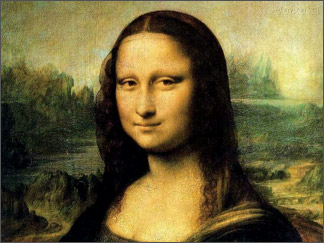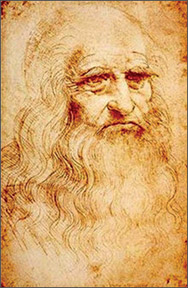|
Leonardo da Vinci, the Renaissance painter:
Achieved much in many different fields
by Amal HEWAVISSENTI
 It
is a cardinal error to deliberately ignore the fact that this
outstanding personality designed bridges, highways, weapons, costumes
and scientific instruments, besides being an eminent architect painter
and a sculptor. To be no less definite, no one in history achieved so
much in so many different fields as did Leonardo da Vinci. He made
dramatic discoveries about the confusing structure of human body
following his invention of the diving bell and most important, the
`flying machine' though they were impossible to be built with the
available materials of the time. It
is a cardinal error to deliberately ignore the fact that this
outstanding personality designed bridges, highways, weapons, costumes
and scientific instruments, besides being an eminent architect painter
and a sculptor. To be no less definite, no one in history achieved so
much in so many different fields as did Leonardo da Vinci. He made
dramatic discoveries about the confusing structure of human body
following his invention of the diving bell and most important, the
`flying machine' though they were impossible to be built with the
available materials of the time.
Da Vinci's notebooks provide evidence that he went beyond the bounds
of convention and he approached science and art in an equal methodical
manner in which he made many sketches to facilitate a successful
resolution after he studied a certain problematic thing. He did not note
an abyss between painting his forte and planning a machine and he became
a wonderful expert in every field that fascinated him. Leonardo spent an
impressive childhood on the family farm with his father, a successful
government official and his mother, a girl from a peasant family. He was
born in 1452 in the town of Vinci, Italy. The early events of his
childhood took place against the backdrop of pastoral joys and his
childhood seems to have provided ample freedom for him to explore the
fields and streams.
 This
blithe experience brought him in love with outdoor life and his
undisguised admiration for natural phenomena shaped his `artistic'
outlook in life. He set off a relentless passion to observe how things
work. Most often he bought caged birds in the market place and set them
free - a habit which revealed he could not resist to see birds encaged
and showed that he wanted to study precisely the flight mechanism of
birds. This
blithe experience brought him in love with outdoor life and his
undisguised admiration for natural phenomena shaped his `artistic'
outlook in life. He set off a relentless passion to observe how things
work. Most often he bought caged birds in the market place and set them
free - a habit which revealed he could not resist to see birds encaged
and showed that he wanted to study precisely the flight mechanism of
birds.
Landmark
The year 1469 was a memorable landmark for him in which he moved with
his father to Florence, where the young man was brought in
apprenticeship to the painter and sculptor Andrea del Verrochio. During
the seven years Leonardo spent in Verrochio's studio he was so deeply
inspired by his teacher's imaginative sculptor that by 1472, Leonardo
became a master of the Painter's Association. It is rumoured that a few
years later, Leonardo's vivid portrayal of an angel drove his master
Verrochio non plussed and he is said to have given up painting for
good.After this, Leonardo's expertise as a painter drastically emerged
and his painting of the "Adoration of the Kings" for the monks of
Scopetto created an international revolutionized image for him. The
`Adoration' a pictorial representation of Virgin Mary in a large
landscape with three kings had a massive imprint on the contemporary
younger painters simply because of Leonardo's use of contrasts of light
and dark. To bring this work of art to perfection Leonardo made many
drawings and what we see today is only the first stage of the painting
by reason that he left the painting unfinished. Leonardo had an
exceptional tendency to abandon his works of art with no thought
whatsoever of the state of completion because after he had puzzled out a
particular problem he switched over to some other project that
fascinated him.
Later on, he left Florence to enter the house of the Duke of Milan
where he was entrusted with the responsibility of painting court
portraits and where he designed costumes, supervised pageants built
machines of war and even installed central heating in the palace itself.
Meanwhile his potential flair for music was beginning to go unchallenged
and he presumably played the musical instruments to entertain the Duke
and his trail who were kept mesmerised by his music. While in Milan,
Leonardo set about to work on his imposing masterpiece, "The Last
Supper", but because of his dawdling work Leonardo chose to paint in oil
on a damp wall rather than employing the fresco technique (use of water
colours on wet plaster).
He did not live long enough to witness that this experimental project
would prove unsuccessful as the painting began to peel immediately after
his death. Even if this painting of irrefutable value bear all the signs
of dilapidation it is still an extraordinary picture by which Leonardo
emphasised the drama of the event by cutting out all the unnecessary
details.
One of the themes central to his personal interest was the study of
the functions and outward contours of human body and like the
contemporary artistes of his time (15th century), he made critical
studies of the outward appearance of the human body. Moreover, his
curiosity and fascination for the functioning of the inner structure of
the human body fell beyond his control and he went into the extent of
dissecting corpses to find out for himself the inner mechanism of the
body.
New findings
Leonardo's classic studies of the structure of the heart were
absolutely advanced and the data of his own research baffled the experts
of human organs during his period.
A close scrutiny into his research career reveals that his
preliminary studies of the human body and animal life later branched out
to study of plants and many exciting discoveries about plant growth were
brought to light as a result.
Frequently these new findings about the plant growth were beset by a
bombardment of negative criticisms because Leonardo had adopted a
totally alien attitude or approach in his study of flora. Immediately
after he arrived in Milan, he embarked on a new project, that is to say,
writing about things which had particular appeal for him and his
personal notebooks, unveil the surprising variety and originality of his
scientific observations.
He seemed to have taken particular care to form theories about the
posture or movement of any object in a creative and inventive way and
often he illustrated his newly formed theories with captivating and
exact drawing. Leonardo was never fastidious about his drawn sketches
but a systematic study of his drawings of machines has enabled the
twentieth century engineers, with modern materials and superb
technology, to build models that work perfectly well. It is interesting
too, to note that his notebooks are hard to read because he employed the
technique of mirror writing to call a halt to any misuse or exploitation
of his ideas.
However, Leonardo's tranquil life in the court of Milan was abruptly
disrupted by the invasion of the French Army and Leonardo with no second
thoughts, decided to escape to Venice while Lodovice, his patron was
taken prisoner. The next year, he moved out to Florence still a
proliferating centre for art and was offered a commission to paint an
altarpiece for a church. It is recorded that when his full-scale
painting of the Virgin and Child was erected on public view, a battery
of people flocked there for two days and appreciated it
enthusiastically.
Painting career
After 1503, his life began to be characterised by a very few
productive years but the most outstanding and only perfected painting of
this period is his nonpareil portrait of a Florentine lady the Mona
Lisa. Nothing in recent history has been subjected to so much
controversy as this unique pictorial depiction of melancholia on a
smiling woman's face.
The strong appeal of this Renaissance portrait springs from the
delicately painted features of the woman's face and the mysteriously
rich `smoky' effects of the mountainous landscape in the blurred
background. Leonardo achieved a historic breakthrough in his painting
career when he was given an assignment to paint a battle scene on a wall
of the Great Hall of the Palazzo Vechchio. For the first time in his
life, Leonardo experimented with wax paint but the artwork began to melt
away at the final stage of completion of the painting. But he was
triumphantly resolute to go ahead with tougher measures and his slight
disappointment only hardened his soul. This bitter reality covered him
with a blanket of depression and disappointment but his experience as a
renowned artist and a scientist made him accept the fact that people
must expect failure of experiments in order to achieve otherwise
resounding success.
Leonardo took advantage of a favourable situation to further upgrade
his experiments when a brother of Pope Leo made a formal invitation to
him to come to Rome. In Rome, Leonardo laid a sound basis for his
artistic thinking and triumphantly proceeded with his fresh experiments.
Somewhere in 1516 Leonardo had to leave Italy to formally accept the
duties of chief painter and royal engineer in the court of the king of
France King Francis who bestowed him a Chateau where he managed to
resume his experiments. Suddenly Leonardo was afflicted with partial
paralysis and so he had to discontinue his career as a painter but he
did not fell prey to a perilous mental breakdown. His mind remained
alive and vivacious, contrary to popular belief.
Leonardo da Vinci, who set impossibly high goals for himself and who
felt the pulse of people of Renaissance breathed his last in his French
chateau on May 2, 1519. Even though he knew his fate hanged in the
balance during his last years he did not become an emotional wreck and
the multitude of people who were paying the last tribute to him got the
rare opportunity to hear the brilliant ideas of their art master. |

